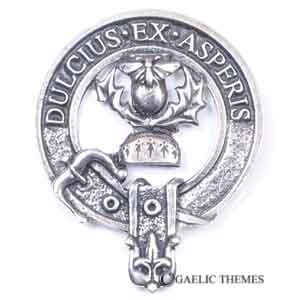Fergusson
Select
- Design: Standard
- Clan Motto: Dulcius ex asperis (Sweeter after difficulties)
- Notes:
Crest: On a chapeau Gules furred Ermine, a bee on a thistle Proper
In Gaelic, ‘MacFhaerghuis’ can be translated either as “son of the angry” or “son of the bold and proud.” Fergussons can be found all across Scotland, from Ross-shire in the north to Dumfriesshire in the southwest. Tradition tries to attribute a common ancestry to the various groups of Fergussons, but there is no evidence.
The Fergussons of Argyllshire claim descent from Fergus Mor mac Erc, an early king of Dalradia. There is evidence linking the Fergussons of Ayrshire and Dumfries with Fergus, Prince of Galloway, an important personage in the reigns of David I and Malcolm IV. Fergus restored the church of Whithorn and founded Dundrennan Abbey in the 12th century.
The Fergussons held the lands of Kilkerran probably from this time, but the first written record is John Fergusson of Kilkerran in 1464. He may have been descended from John, son of Fergus, a witness to a charter of Edward Bruce signed at Turnberry after the battle of Bannockburn.
Bvy 1600 Fergussons could be found all across the southern part of Carrick, all of whom acknowledged Kilkerran as their chief. These sided with the Kennedys in their feud with the Lairds of Bargany.
The Ayrshire Fergussons adopted the Protestant faith during the Reformation. Sir John Fergusson of Kilkerran supported the Royalist cause in the Civil War.
Born in 1653, Sir John Fergusson was a distinguished lawyer and member of the Faculty of Advocates in 1681. He was created a Baronet of Nova Scotia in 1703. His son James was a Judge of the Supreme Court and granted the title Lord Kilkerran in 1735.
General Sir Charles Fergusson of Kilkerran was a career officer who served in Egypt and the Sudan in 1895. He was the youngest major general in World War I and later served as military governor of occupied German territory. From 1924 to 1930 he was Governor General of New Zealand. The present clan chief still lives at Kilkerran House in Ayrshire.
Cadets of the Kilkerran house are the Fergussons of Dunfallandy, near Pitlochry in Atholl. Dunfallandy Fergussons were ardent Jacobites who rose up in the the Fifteen and the Forty-five. General Archibald Fergusson of Dunfallandy served with the East India Company. He was wounded at the battle of Seringapatam in 1799.
Lieutenant Colonel Patrick Fergusson, of the Pitfour branch, invented the first breach-loading rifle used by the British military, patented in 1776.
Robert Fergusson, who died in 1774, was an accoladed poet -- the most admired of Robert Burns.
